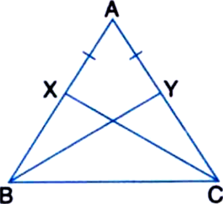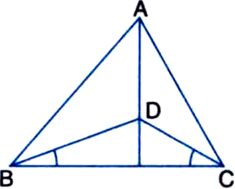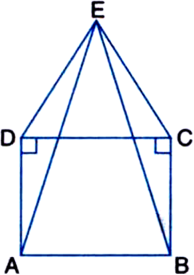 Short Answer Type
Short Answer Type

Given: AB = AC, D is the point in the interior of ∆ABC such that ∠DBC = ∠DCB.
To Prove: AD bisects ∠BAC of ∆ABC.
Proof: In ∆DBC,
∵ ∠DBC = ∠DCB ...(1) | Given
∴ DB = DC ...(2)
| Sides opposite to equal angles of a triangle are equal
In ∆ABC,
∵ AB = AC | Given
∴ ∠ABC = ∠ACB
∴ ∠ABC = ∠ACB ...(3)
| Angles opposite to equal sides of a triangle are equal
Subtracting (1) from (3), we get,
∠ABC - ∠DBC = ∠ACB - ∠DCB
⇒ ∠ABD = ∠ACD ...(4)
In ∆ADB and ∆ADC,
AB = AC | Given
DB = DC | Proved in (2)
∠ABD = ∠ACD | Proved in (4)
∴ ∆ADB ≅ ∆ADC
| SAS congruence rule
∴ ∠DAB = ∠DAC | CPCT
⇒ AD bisects ∠BAC of ∆ABC.
 Long Answer Type
Long Answer TypeIn figure, ABCD is a square and ∠DEC is an equilateral triangle. Prove that
(i) ∆ADE ≅ ∆BCE
(ii) AE = BE
(iii) ∠DAE = 15°
 Short Answer Type
Short Answer Type